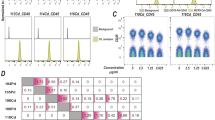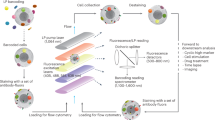Abstract
Mass-tag cell barcoding (MCB) labels individual cell samples with unique combinatorial barcodes, after which they are pooled for processing and measurement as a single multiplexed sample. The MCB method eliminates variability between samples in antibody staining and instrument sensitivity, reduces antibody consumption and shortens instrument measurement time. Here we present an optimized MCB protocol. The use of palladium-based labeling reagents expands the number of measurement channels available for mass cytometry and reduces interference with lanthanide-based antibody measurement. An error-detecting combinatorial barcoding scheme allows cell doublets to be identified and removed from the analysis. A debarcoding algorithm that is single cell–based rather than population-based improves the accuracy and efficiency of sample deconvolution. This debarcoding algorithm has been packaged into software that allows rapid and unbiased sample deconvolution. The MCB procedure takes 3–4 h, not including sample acquisition time of ∼1 h per million cells.
This is a preview of subscription content, access via your institution
Access options
Subscribe to this journal
Receive 12 print issues and online access
$259.00 per year
only $21.58 per issue
Buy this article
- Purchase on Springer Link
- Instant access to full article PDF
Prices may be subject to local taxes which are calculated during checkout







Similar content being viewed by others
References
Fulton, R.J., McDade, R.L., Smith, P.L., Kienker, L.J. & Kettman, J.R. Advanced multiplexed analysis with the FlowMetrix system. Clin. Chem. 43, 1749–1756 (1997).
Parameswaran, P. et al. A pyrosequencing-tailored nucleotide barcode design unveils opportunities for large-scale sample multiplexing. Nucleic Acids Res. 35, e130 (2007).
Meyer, M., Stenzel, U., Myles, S., Prüfer, K. & Hofreiter, M. Targeted high-throughput seoquencing of tagged nucleic acid samples. Nucleic Acids Res. 35, e97 (2007).
Krutzik, P.O. & Nolan, G.P. Fluorescent cell barcoding in flow cytometry allows high-throughput drug screening and signaling profiling. Nat. Methods 3, 361–368 (2006).
Bandura, D.R. et al. Mass cytometry: technique for real-time single cell multitarget immunoassay based on inductively coupled plasma time-of-flight mass spectrometry. Anal. Chem. 81, 6813–6822 (2009).
Bodenmiller, B. et al. Multiplexed mass cytometry profiling of cellular states perturbed by small-molecule regulators. Nat. Biotechnol. 30, 858–867 (2012).
Finck, R. et al. Normalization of mass cytometry data with bead standards. Cytometry A 83, 483–494 (2013).
Behbehani, G.K. et al. Transient partial permeabilization with saponin enables cellular barcoding prior to surface marker staining. Cytometry A 85, 1011–1019 (2014).
Majonis, D., Ornatsky, O., Kinach, R. & Winnik, M.A. Curious results with palladium- and platinum-carrying polymers in mass cytometry bioassays and an unexpected application as a dead cell stain. Biomacromolecules 12, 3997–4010 (2011).
Qiu, P. et al. Extracting a cellular hierarchy from high-dimensional cytometry data with SPADE. Nat. Biotechnol. 29, 886–891 (2011).
Amir, E.D. et al. viSNE enables visualization of high-dimensional single-cell data and reveals phenotypic heterogeneity of leukemia. Nat. Biotechnol. 31, 545–552 (2013).
Bruggner, R.V., Bodenmiller, B., Dill, D.L., Tibshirani, R.J. & Nolan, G.P. Automated identification of stratifying signatures in cellular subpopulations. Proc. Natl. Acad. Sci. USA 111, E2770–E2777 (2014).
Hamady, M., Walker, J.J., Harris, J.K., Gold, N.J. & Knight, R. Error-correcting barcoded primers for pyrosequencing hundreds of samples in multiplex. Nat. Methods 5, 235–237 (2008).
Acknowledgements
We thank A. Trejo and A. Jager for mass cytometry quality control and instrument maintenance. We thank E. Simonds and P. Krutzik for their helpful discussions. This work was supported by grants from the US National Institutes of Health (NIH) (U19 AI057229, U54CA149145, N01-HV-00242, 1U19AI100627, 5R01AI07372405, R01CA184968, 1 R33 CA183654, NRSA F32 GM093508-01, 152175.5041015.0412 and R01 A1073724), NIH-the Baylor Research Institute (41000411217), the NIH-Northrop Grumman Corp. (7500108142), the California Institute for Regenerative Medicine (CIRM) (DR1-01477, RB2–01592), the US Department of Defense (OC110674), the European Commission (Health.2010.1.2-1), the US Food and Drug Administration (HHSF223201210194C), the Bill and Melinda Gates Foundation (OPP 1017093), the Alliance for Lupus Research, the Lymphoma Research Foundation, the Entertainment Industry Foundation (National Women's Cancer Research Alliance grant) and the National Science Foundation CAREER award (MCB-1149728). D.P. holds a Packard Fellowship for Science and Engineering. G.P.N. holds the Rachford and Carlota A. Harris Endowed Professorship.
Author information
Authors and Affiliations
Contributions
E.R.Z. developed the palladium MCB reagents and labeling protocol, implemented the doublet-filtering barcode scheme, developed the single-cell debarcoding algorithm, designed and performed the experiments, analyzed the data and wrote the manuscript; R.F. developed the single-cell debarcoding algorithm, designed and implemented the debarcoding software, designed the experiments, analyzed the data and wrote the manuscript; G.K.B. developed the palladium MCB reagents and labeling protocol, developed the saponin-mediated MCB labeling and wrote the manuscript; E.D.A. developed the doublet-filtering barcode scheme; S.K. assisted with developing barcode deconvolution methods; V.D.G. performed experiments; C.G.L. performed experiments; Z.B. performed experiments and wrote the manuscript; M.H.S. performed experiments; B.B. developed the palladium MCB reagents and labeling protocol; W.J.F. designed the experiments and wrote the manuscript; D.P. developed the doublet-filtering barcode scheme and wrote the manuscript; G.P.N. designed the experiments and wrote the manuscript.
Corresponding author
Ethics declarations
Competing interests
G.P.N. has a personal financial interest in the company Fluidigm, the manufacturer of the mass cytometer used in this manuscript. R.F. has been a paid consultant for the company DVS Sciences, the original manufacturer of the mass cytometer that has since merged with Fluidigm. G.K.B. has been a paid consultant for both DVS Sciences and Fluidigm.
Integrated supplementary information
Supplementary Figure 1 Palladium barcode staining intensity across cell lines of different cell sizes.
BC2 (Pd104) staining intensity in surface marker gated OVCAR and U937 cells from five barcoded samples, all of which are positive for BC2. Debarcoding was done independently of cell type gating.
Supplementary Figure 2 Time-of-flight traces of palladium barcodes of singlets and doublets with overlapping event lengths and Ir-intercalator intensities.
(a) Example cell events are indicated on the event length x Ir-Intercalator biaxial plot. Event 1 is identified as a barcode singlet, but is of similar length and Ir-intercalator intensity as event 4, which has been identified as a barcode doublet. Similarly, event 2 is of similar length and Ir-Intercalator intensity as event 3. (b) The per-spectrum traces of the barcoding channels from the IMD files confirm the barcode and single/doublet assignments.
Supplementary Figure 3 Gates used for Figure 6b.
(a) Singlet gates of increasing stringency and their percent yields. (b) The percent of CD4+CD8+ cells within each of the singlet gates shown in (a).
Supplementary Figure 4 96-well plate layout for MCB reagent titration in triplicate.
(a) Serial dilution layout for the 6 Palladium MCB reagents. (b) Wells to pool before for mass cytometry measurement.
Supplementary Figure 5 Plate layout for 6-choose-3 MCB combinatorial doublet-filtering scheme.
(a) MCB reagent combinations to use for a 20 sample 6-choose-3 combinatorial doublet-filtering scheme. (b) Mapping the 20 samples to a 5 x 4 grid. (c) Pipetting guide for each of the 6 Palladium MCB reagents into the 5 x 4 grid.
Supplementary Figure 6 Pooled sample groups for 20-sample MCB combinatorial plate testing and validation.
Wells to pool for 8 pooled sample groups that will be used to validate the sample assignment and correct orientation of the tested 100X MCB combinatorial plate.
Supplementary information
Supplementary Text and Figures
Supplementary figures 1–6 (PDF 2386 kb)
Rights and permissions
About this article
Cite this article
Zunder, E., Finck, R., Behbehani, G. et al. Palladium-based mass tag cell barcoding with a doublet-filtering scheme and single-cell deconvolution algorithm. Nat Protoc 10, 316–333 (2015). https://doi.org/10.1038/nprot.2015.020
Published:
Issue Date:
DOI: https://doi.org/10.1038/nprot.2015.020
Comments
By submitting a comment you agree to abide by our Terms and Community Guidelines. If you find something abusive or that does not comply with our terms or guidelines please flag it as inappropriate.



